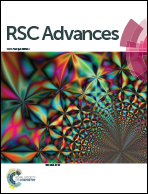Agarose–guar gum assisted synthesis of processable polyaniline composite: morphology and electro-responsive characteristics†
Abstract
The present communication reports the development of processable polyaniline (PANI) in the film form via agarose–guar gum (A–G) assisted in situ polymerization of aniline using potassium dichromate as an oxidant. The network structure of A–G not only provides the mechanical support to polyaniline, but also a microporous template, which allows the reinforcement of PANI into nanostructures with an interpenetrated polymer network between PANI and A–G, as evidenced by optical microscopy and SEM. The FTIR and TGA analysis confirms the formation of an agarose–guar gum–polyaniline composite (A–G–PANI) having hydrogen bonding interactions. The A–G–PANI film has better adherence property on the glass substrate as compared with PANI. The A–G–PANI composite shows appreciable DC conductivity in the range of 10−3–10−2 S cm−1 and electrochemical activity, having oxidation–reduction transitions corresponding to polyaniline. It exhibits both ionic and electronic conductivity as confirmed by EIS. The electro-responsive characteristics exhibited by the novel A–G–PANI composite make it a promising electrode material for the construction of chemical sensors and biosensors.


 Please wait while we load your content...
Please wait while we load your content...